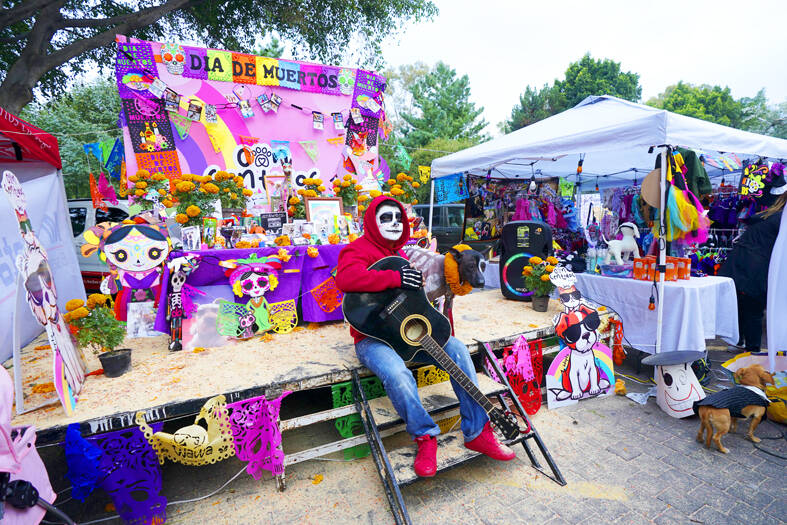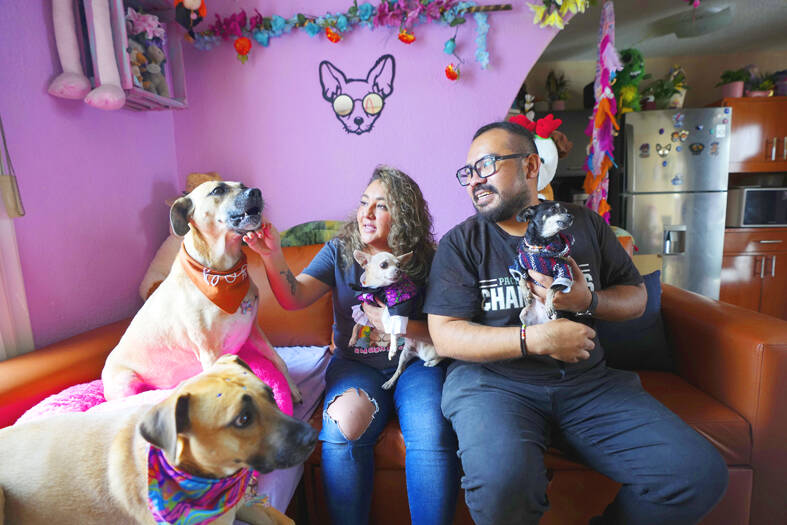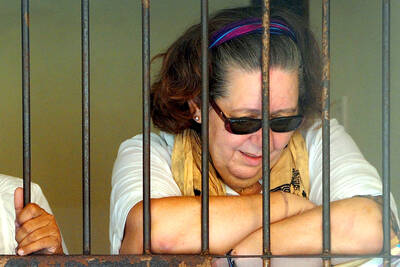Pets are not forgotten during Mexico’s Day of the Dead celebrations, when even Fido and Tiger get a place at the altars Mexican families set up to honor their deceased loved ones, complete with flowers, candles and photographs.
Although the human dead usually get their favorite food or drink placed on altars, the nature of pet food can make things a little different.
The holiday has roots in Mexican pre-Hispanic customs, as does the reverence for animals. The small, hairless dogs that Mexicans kept before the Spanish conquest were believed to help guide their owners to the afterlife, and were sometimes given special burials.

Photo: AP
The Day of the Dead starts annually on Oct. 31 to remember those humans who died in accidents. It continues on Nov. 1 to mark those who died in childhood, while Nov. 2 memorialize those who died as adults.
Observances include families cleaning and decorating graves, which are covered with orange marigolds. At cemeteries and home altars, relatives light candles, and put out offerings of the favorite foods and beverages of their deceased relatives.
The presence of pets has gained such momentum that now Oct. 27 is considered Day of the Dead for pets and the Mexican National Anthropology and History Institute includes tips on its social platforms for how to include them in altars.

Photo: AP
Mexico City graphic designer Meztli Lizaola makes sure every year that her beloved tawny-coated Chihuahua, Taco — who died two years ago — has a place at the altar on a table in the corner of her living room.
Taco’s ashes are in an urn beside his lively eyed photograph, next to a photo of Lizaola’s deceased father.
The orange-flowered cempasuchil — a type of marigold — is placed around the photos, as well as candles and figurines of skulls.
Taco — as his name suggests — enjoyed tacos (especially roast pork) and other traditional Mexican human foods such as quesadillas and concha pastries.
Because she has four other dogs, Lizaola cannot leave Taco’s favorite foods on the altar; some sneaky pup is likely to snatch it.
For years, elements of Halloween have been mixing into the seasonal festivities, and for pets it is no different. For those who still have living dogs and cats, it is not uncommon to find a wide variety of Halloween costumes at pet shops, including inmate-style “bad dog” costumes.
Ethnohistorian Juan Pablo Garcia Uriostegui of the National Museum of Anthropology said the inclusion of pets and Halloween influences are part of changes in the traditional holiday that have accelerated, particularly in the past three years.
“We are experiencing changes in the traditions. It is happening very fast,” he said.
The large family of numerous children is often a thing of the past, and couples having only pets — dubbed “perrihijos” or “dog kids” — are not uncommon.
“That’s where you see these practices concerning death starting to take hold,” Garcia Uriostegui said. “They are no longer just another companion ... they are living beings who hold memories, and whose memory must be commemorated.”
The admiration for dogs goes way back in Mexico, where hairless dogs known as xoloitzcuintles were common before the Spanish brought their larger, furrier hounds to Mexico during the 1519-1521 conquest.
The pre-Hispanic dogs were often sacrificed or buried near their owners — or represented as carefully crafted ceramic figurines — because the owner would need the dogs’ keen senses to find the path to the underworld after death.
Lizaola still feels Taco’s absence. His face is tattooed on her right arm. The dog changed her life and that of her partner.
“There’s like a before and after in my life,” she said, adding that Taco inspired them to get more involved in supporting abandoned animals and rescuing dogs from the street.
Initially, there was some resistance within her family to including Taco on the altar, a place long reserved for departed family members.
However, as relatives’ pets died they came around and “now it’s more dogs than humans,” she said.

A missing fingertip offers a clue to Mako Nishimura’s criminal past as one of Japan’s few female yakuza, but after clawing her way out of the underworld, she now spends her days helping other retired gangsters reintegrate into society. The multibillion-dollar yakuza organized crime network has long ruled over Japan’s drug rings, illicit gambling dens and sex trade. In the past few years, the empire has started to crumble as members have dwindled and laws targeting mafia are tightened. An intensifying police crackdown has shrunk yakuza forces nationwide, with their numbers dipping below 20,000 last year for the first time since records

CAUSE UNKNOWN: Weather and runway conditions were suitable for flight operations at the time of the accident, and no distress signal was sent, authorities said A cargo aircraft skidded off the runway into the sea at Hong Kong International Airport early yesterday, killing two ground crew in a patrol car, in one of the worst accidents in the airport’s 27-year history. The incident occurred at about 3:50am, when the plane is suspected to have lost control upon landing, veering off the runway and crashing through a fence, the Airport Authority Hong Kong said. The jet hit a security patrol car on the perimeter road outside the runway zone, which then fell into the water, it said in a statement. The four crew members on the plane, which

Japan’s ruling Liberal Democratic Party (LDP) and its junior partner yesterday signed a coalition deal, paving the way for Sanae Takaichi to become the nation’s first female prime minister. The 11th-hour agreement with the Japan Innovation Party (JIP) came just a day before the lower house was due to vote on Takaichi’s appointment as the fifth prime minister in as many years. If she wins, she will take office the same day. “I’m very much looking forward to working with you on efforts to make Japan’s economy stronger, and to reshape Japan as a country that can be responsible for future generations,”

Indonesia was to sign an agreement to repatriate two British nationals, including a grandmother languishing on death row for drug-related crimes, an Indonesian government source said yesterday. “The practical arrangement will be signed today. The transfer will be done immediately after the technical side of the transfer is agreed,” the source said, identifying Lindsay Sandiford and 35-year-old Shahab Shahabadi as the people being transferred. Sandiford, a grandmother, was sentenced to death on the island of Bali in 2013 after she was convicted of trafficking drugs. Customs officers found cocaine worth an estimated US$2.14 million hidden in a false bottom in Sandiford’s suitcase when